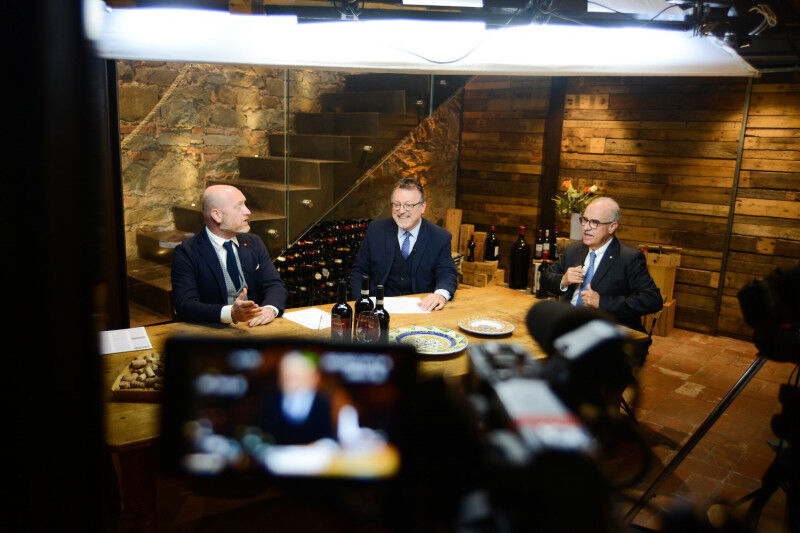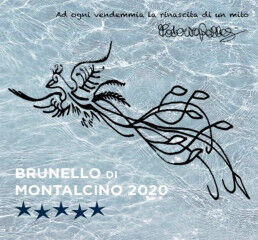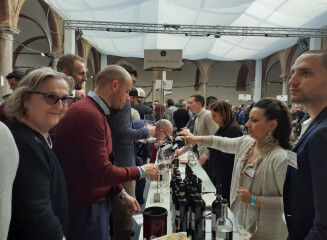BRUNELLO OFF 2021 AND THE 2016 VINTANGE, FIRST IMPRESSIONS
Filippo Bartolotta and Francesca Ciancio jointly participated on March 20th at the Benvenuto Brunello OFF event hosted by the Consorzio del Vino Brunello di Montalcino. This yearly event is held in order to present each year’s upcoming vintage, a much-anticipated wine event attended by industry insiders and international wine enthusiasts alike. This year’s event covered the Brunello di Montalcino DOCG 2016 vintage, a selection largely identified as being of legendary standing. Between sips and reflections, an article based on sensations and impressions resulted. Here, our two journalists and tasters discuss the present and the future of one of the most famous wine appellations in the world. Six Q&As for each journalist, resulting in a sort of poetic tercet about this Sangiovese-based wine.
Francesca: First impressions of wine tasting during the time of Covid.
Filippo: Happiness and nostalgia together. I’m so grateful to have the opportunity to taste like we used to do, in a perfect tasting environment: And yet, I’m also nostalgic for the great dinners and the warm interactions from previous sessions with local producers and colleagues.
The empty parking area at the Fortezza di Montalcino at 9:45am would have been unthinkable in past editions.
The day itself being lashed by a Grecale wind that forced me to dress warmly on this unexpectedly chilly final day before Spring’s official calendar arrival.
An intriguing coincidence strikes me: March 21st, 2021 marks my 21st year of tasting at Benvenuto Brunello.
Feelings of nostalgia and sentiment assail me - destiny seemed to indicate the Benvenuto Brunello event would be skipped this year, yet here we are. I’m thankfully now ready once again to leap into the world of great Brunello wines once more.
Filippo: What are your impressions of the 48 hours of Benvenuto Brunello 2021?
Francesca: I have to agree with you, there is something strikingly coincidental that in 2020, this was the last great public event where we participated in a group. It was precisely in Montalcino, last year, that we signed our very first self-certification. Who could have possibly foreseen it would be the first of many?! The Consortium was courageous and took on a position of tremendous responsibility - they musth have known many would answer their call to participate. Which, by the way, is precisely what happened.
As for me, this time represents priceless self-pampering moments on so many levels. I’m comforted during this experience by the passion I feel for Brunello wines, by Anna's delicious hazelnut and carrot cakes at the Hotel Il Giglio, by my favorite Table #5 right next to the window overlooking the entire Val D'Orcia at the Hotel il Giglio restaurant.
I’m gratified by the Instagram-perfect photos viewable from every angle of this territory, and by the unexpected encounters Montalcino provides with each visit. That chilly icy wind you mentioned also brought visions of Monte Amiata’s snow-capped sides, as a stark contrast to the blue skies you can only find here. Let’s not forget those stunning starry nights of Montalcino.
Francesca: Vintage 2016 - can we find a new angle for this vintage that nobody’s already said? Kidding aside, how important is it to understand the longevity of a vintage in order to celebrate its greatness?
Filippo: Producers today succeed in bottling wines that are immediately enjoyable, full of expressiveness. The great ones, however, are those where we will find freshness even in two/three decades from now.
Filippo: And for you, are they wines in which readiness or aging potential prevails?
Francesca: I feel like this is becoming more of a false question than anything. In my opinion, I believe the notion of making a wine fit to last an eternity doesn’t have to be a guiding philosophy and longer. The bottom line guiding the production process is to simply make the best wine possible. If the wine is excellent quality, it’s a logical concept that said wine will also last a long time.
Obviously, there are more "precise" vintages and other "lengthy" vintages, which means that fortunately, we can find an important nature-focused imprint. Today, we’re discovering more and more wines that are good to drink now, that are also wines great to keep on hand for the future - I’m calling these “multi-temporal” wines.
This phenomena is possible, in my opinion, thanks to the increased viticultural awareness and the notion of increased importance fully ripened, mature grapes have on the eventual structure of wines.
Francesca: How does the 2016 vintage look today and in the future?
Filippo: This is definitely one of the greatest vintages, for wines able to combine enjoyability and longevity. If I had to choose between the two features, I'd go for longevity.
Filippo: And what is your overall impression of the 2016 vintage?
Francesca: Overall, quite positive - do you know how I know? Because I use a parameter that’s never wrong: fun. Tasting 50, 100, 150 Brunello wines one after the other, isn’t easy, and the risk of monotonous wine experiences is always just around the corner. But, with the right vintage on hand, tasting so many wines becomes fun, and you’re not just going through the motions.
My vote for the 2106 vintage is very good, but not spectacular. I’m tasting a lot of alcoholic notes, and a bitter mouth-finish still is prevalent in the wines.
I have noted the wines’ decreasing density: we find fewer and fewer examples of impenetrable, dark liquids, and loads more options of transparent wines. These are bright red tones which the eye has no problem seeing right through.
In maintaining this lighter consistency, the wines translate into a certain finesse and elegance on the nose and mouth, and steps away from the heavier wood aromas. Instead, we find flavours of flowers and fruits that are anything but explosive. This vintage is representative of harmony, where we have a little bit of everything that results in perfect balance.
Francesca: What do you like about Brunello di Montalcino? This question is posited to the Tuscan wine taster who knows Sangiovese like the back of his hand.
Filippo: What I love about this Tuscan land is the ability of the great Brunello wines to be generous and austere at the same time. Wines that are accessible to everyone but at the same time, can give so much joy to the most demanding experts.
Filippo: Reviewing your tasting notes, do some areas emerge better than others?
Francesca: Earlier, I mentioned my surprise at finding very alcoholic, powerful wines so present still. Because of this, I wanted to discover these wines birthplaces, and the surprising answer is that not all of them were born in the hottest climates.
I believe this means that in a vintage like that of 2016, which enjoyed quasi-perfect weather, which can result in stressful or difficult vineyard management, much depends on the so-called “expertise of the winemaker.” This figure is always a person with loads of experience, who has previous experience working with classic vintages, with dry or rainy springs, during those years where attention is always turned on.
The September rains, for instance, that were surely annoying, but were followed by good ventilation and strong day-to-night temperature swings that helped the grapes find their balance.
Francesca: What differences can we find between the Brunello '16, Selezione '16 and Riserva 2015?
Filippo: I'll start from the bottom.
Brunello Riserva 2015 wines are sunny, very sweet and filled with ripe fruit. These are ideal wines for aging, but that are more affable than expected.
The '16 is a classic vintage that highlights the wine’s brilliant and transparent colors on the brilliance and transparency of the color. This results in an awareness of the wine’s speed, and its change of pace.
With the Selezione ’16, a new game is being played in Montalcino. Starting from this year, we’re beginning to see more interesting numbers that should help us be able to investigate the characteristics of the Montalcino area, and we can learn more about the wines that have already turned out so well!
Filippo: What about Rosso di Montalcino?
Francesca: I must confess that I’ve discovered this wine late in the game. I never had time to finish my tastings, and always ended up saving this wine for last. I solved the problem by drinking it outside the context of the Anteprima. I discovered a wine that has a life of its own, a story all its own.
Calling it a "second vin" is quite reductive. What I like about Rosso di Montalcino is its juiciness, the livelier and spirited matrix of Sangiovese. This is a wine that reminds you that we’re in southern Tuscany, albeit with greatly varying altitudes, and that the Mediterranean is always at hand. Meaning, if in Brunello wines you find spices, in the Rosso, you’re more likely to sense aromatic herbs.
Francesca: I'll copy your question... is Rosso di Montalcino a close second wine, or will it blossom eventually and win its own races?
Filippo: I have always loved with Rosso, which I consider one of the "best buys" on the Italian scene. A piece of advice: try buying a case of 6 or 12 bottles, drink half promptly, and forget the rest in the cellar for about ten years. Then, we’ll talk again!
Filippo: Wrapping up, from a food pairing perspective, how do you think this vintage fares?
Francesca: As you know, in 1961 Luigi Veronelli's "Vini d'Italia" was published, the book that created the notion of great wine and food critics as actual authors as well. In speaking of Brunello, the writer from Bergamo indicated Brunello as the best Italian wine to pair with red meat. In ancient writings, it’s even mentioned as a drink for roast meat.
The culinary traditions of Montalcino and Val D'Orcia certainly do not call upon fish dishes. Today, I’m going with pairings based on the concepts of transparencies and forthrightness of local ingredients.
So, for an elegant, straightforward 2016 Brunello, I see pairing seamlessly with a classic grilled Chianina steak without any dressings. We can also picture the 2016 Brunello paired with local Pecorino cheese, or with soups cooked with Spelt and legumes. Let’s not forget that Montalcino is Italy’s largest Spelt producers. For a bit more luxe aromas, try the 2016 Brunello with local Tuscan truffles, making Brunello into a cousin of sorts of the Piedmontese wines, Barolo and Barbaresco!
Be sure to head to the Consortium of Brunello di Montalcino Wines page to learn more about how they’re working to spread the word of Brunello wines across the globe. Love learning about Brunello wines? Check out the Video segments on Mamablip’s video archive for loads of wine tastings led by Filippo Bartolotta exploring select Montalcino wineries. Want to learn even more about the Montalcino wine region? Don’t miss the Miracle of Montalcino video series Filippo guides as we take a closer look at one of Tuscany’s most renowned wine areas.
Don't forget to register for Mamablip's weekly newsletter for updates on all the exciting newest Mamablip Blog articles, recipes and other wine news from Italy.



